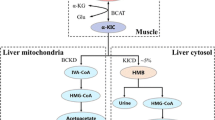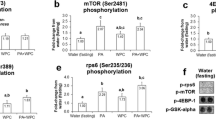Abstract
Purpose
Protein synthesis and proteolysis are known to be controlled through mammalian target of rapamycin, AMP-activated kinase (AMPK) and general control non-derepressible 2 (GCN2) pathways, depending on the nutritional condition. This study aimed at investigating the contribution of liver AMPK and GCN2 on the adaptation to high variations in protein intake.
Methods
To evaluate the answer of protein pathways to high- or low-protein diet, male wild-type mice and genetically modified mice from C57BL/6 background with liver-specific AMPK- or GCN2-knockout were fed from day 25 diets differing in their protein level as energy: LP (5%), NP (14%) and HP (54%). Two hours after a 1 g test meal, protein synthesis rate was measured after a 13C valine flooding dose. The gene expression of key enzymes involved in proteolysis and GNC2 signaling pathway were quantified.
Results
The HP diet but not the LP diet was associated with a decrease in fractional synthesis rate by 29% in the liver compared to NP diet. The expression of mRNA encoding ubiquitin and Cathepsin D was not sensitive to the protein content. The deletion of AMPK or GCN2 in the liver did not affect nor protein synthesis rates and neither proteolysis markers in the liver or in the muscle, whatever the protein intake.
In the postprandial state, protein level alters protein synthesis in the liver but not in the muscle.
Conclusions
Taken together, these results suggest that liver AMPK and GCN2 are not involved in this adaptation to high- and low-protein diet observed in the postprandial period.

Similar content being viewed by others
Abbreviations
- AMPK:
-
AMP-activated kinase
- ASR:
-
Absolute synthesis rate
- Atf4:
-
Activating transcription factor 4
- Ddit3:
-
DNA damage-inducible transcript 3
- eIF2α:
-
Eukaryotic initiation factor 2α
- FSR:
-
Fractional protein synthesis rate
- GCN2:
-
General control non-derepressible 2
- HP:
-
High protein
- KO:
-
Knock-out
- LP:
-
Low protein
- mTOR:
-
Mammalian target of rapamycin
- NP:
-
Normo-protein
- P:
-
Protein content
- P20:
-
20% Protein diet
- Trib3:
-
Tribbles homolog 3
- TSC1:
-
Tuberous sclerosis complex 1
- TSC2:
-
Tuberous sclerosis complex 2
- ULK1:
-
Unc-51 like autophagy activating kinase
- WT:
-
Wild-type
References
Morrison CD, Laeger T (2015) Protein-dependent regulation of feeding and metabolism. Trends Endocrinol Metab TEM 26:256–262. https://doi.org/10.1016/j.tem.2015.02.008
Hursel R, Martens EAP, Gonnissen HKJ et al (2015) Prolonged adaptation to a low or high protein diet does not modulate basal muscle protein synthesis rates—a substudy. PLoS ONE 10:e0137183. https://doi.org/10.1371/journal.pone.0137183
Batistela E, Pereira MP, Siqueira JT et al (2014) Decreased rate of protein synthesis, caspase-3 activity, and ubiquitin–proteasome proteolysis in soleus muscles from growing rats fed a low-protein, high-carbohydrate diet. Can J Physiol Pharmacol 92:445–454. https://doi.org/10.1139/cjpp-2013-0290
dos Santos MP, Batistela E, Pereira MP et al (2016) Higher insulin sensitivity in EDL muscle of rats fed a low-protein, high-carbohydrate diet inhibits the caspase-3 and ubiquitin-proteasome proteolytic systems but does not increase protein synthesis. J Nutr Biochem 34:89–98. https://doi.org/10.1016/j.jnutbio.2016.04.008
Wykes LJ, Fiorotto M, Burrin DG et al (1996) Chronic low protein intake reduces tissue protein synthesis in a pig model of protein malnutrition. J Nutr 126:1481
Yoshizawa F, Kimball SR, Vary TC, Jefferson LS (1998) Effect of dietary protein on translation initiation in rat skeletal muscle and liver. Am J Physiol-Endocrinol Metab 275:E814–E820
Deng D, Yao K, Chu W et al (2009) Impaired translation initiation activation and reduced protein synthesis in weaned piglets fed a low-protein diet. J Nutr Biochem 20:544–552. https://doi.org/10.1016/j.jnutbio.2008.05.014
Chevalier L, Bos C, Gryson C et al (2009) High-protein diets differentially modulate protein content and protein synthesis in visceral and peripheral tissues in rats. Nutr Burbank Los Angel Cty Calif 25:932–939. https://doi.org/10.1016/j.nut.2009.01.013
Masanes R, Fernandez-Lopez JA, Alemany M et al (1999) Effect of dietary protein content on tissue protein synthesis rates in Zucker lean rats. Nutr Res 19:1017–1026
Taillandier D, Guezennec C-Y, Patureau-Mirand P et al (1996) A high protein diet does not improve protein synthesis in the nonweight-bearing rat tibialis anterior muscle. J Nutr 126:266–272
Chevalier L, Bos C, Azzout-Marniche D et al (2010) Dietary protein regulates hepatic constitutive protein anabolism in rats in a dose-dependent manner and independently of energy nutrient composition. Am J Physiol Regul Integr Comp Physiol 299:R1720-1730. https://doi.org/10.1152/ajpregu.00497.2010
Chotechuang N, Azzout-Marniche D, Bos C et al (2011) Down-regulation of the ubiquitin-proteasome proteolysis system by amino acids and insulin involves the adenosine monophosphate-activated protein kinase and mammalian target of rapamycin pathways in rat hepatocytes. Amino Acids 41:457–468. https://doi.org/10.1007/s00726-010-0765-2
Dever TE, Hinnebusch AG (2005) GCN2 whets the appetite for amino acids. Mol Cell 18:141–142. https://doi.org/10.1016/j.molcel.2005.03.023
Thomson A, Smart K, Somerville MS et al (2019) The Ussing chamber system for measuring intestinal permeability in health and disease. BMC Gastroenterol 19:98. https://doi.org/10.1186/s12876-019-1002-4
Janzen NR, Whitfield J, Hoffman NJ (2018) Interactive roles for AMPK and glycogen from cellular energy sensing to exercise metabolism. Int J Mol Sci 19:3344. https://doi.org/10.3390/ijms19113344
Rothschild JA, Islam H, Bishop DJ et al (2021) Factors influencing AMPK activation during cycling exercise: a pooled analysis and meta-regression. Sports Med Auckl NZ. https://doi.org/10.1007/s40279-021-01610-x
Chalvon-Demersay T, Even PC, Chaumontet C et al (2017) Modifying the dietary carbohydrate-to-protein ratio alters the postprandial macronutrient oxidation pattern in liver of AMPK-deficient mice. J Nutr 147:1669–1676. https://doi.org/10.3945/jn.117.250803
Morens C, Gaudichon C, Metges CC et al (2000) A high-protein meal exceeds anabolic and catabolic capacities in rats adapted to a normal protein diet. J Nutr 130:2312–2321. https://doi.org/10.1093/jn/130.9.2312
Vidal-Lletjós S, Khodorova NV, Piscuc M et al (2021) Tissue-specific effect of colitis on protein synthesis in mice: impact of the dietary protein content. Eur J Nutr 60:1669–1677. https://doi.org/10.1007/s00394-020-02365-3
Petzke KJ, Elsner A, Proll J et al (2000) Long-term high protein intake does not increase oxidative stress in rats. J Nutr 130:2889–2896. https://doi.org/10.1093/jn/130.12.2889
Schutt AK, Blesson CS, Hsu JW et al (2019) Preovulatory exposure to a protein-restricted diet disrupts amino acid kinetics and alters mitochondrial structure and function in the rat oocyte and is partially rescued by folic acid. Reprod Biol Endocrinol RBE 17:12. https://doi.org/10.1186/s12958-019-0458-y
Stepien M, Azzout-Marniche D, Even PC et al (2016) Adaptation to a high-protein diet progressively increases the postprandial accumulation of carbon skeletons from dietary amino acids in rats. Am J Physiol Regul Integr Comp Physiol 311:R771–R778. https://doi.org/10.1152/ajpregu.00040.2016
Welle S, Bhatt K, Pinkert CA (2006) Myofibrillar protein synthesis in myostatin-deficient mice. Am J Physiol Endocrinol Metab 290:E409–E415. https://doi.org/10.1152/ajpendo.00433.2005
Bregendahl K, Yang X, Liu L et al (2008) Fractional protein synthesis rates are similar when measured by intraperitoneal or intravenous flooding doses of L-[ring-2H5]phenylalanine in combination with a rapid regimen of sampling in piglets. J Nutr 138:1976–1981. https://doi.org/10.1093/jn/138.10.1976
Corr LT, Berstan R, Evershed RP (2007) Optimisation of reparationon procedures for the determination of delta13C values of amino acids by gas chromatography/combustion/isotope ratio mass spectrometry. Rapid Commun Mass Spectrom 21:3759–3771
Chalvon-Demersay T, Even PC, Tomé D et al (2016) Low-protein diet induces, whereas high-protein diet reduces hepatic FGF21 production in mice, but glucose and not amino acids up-regulate FGF21 in cultured hepatocytes. J Nutr Biochem 36:60–67. https://doi.org/10.1016/j.jnutbio.2016.07.002
Prod’homme M, Balage M, Debras E et al (2005) Differential effects of insulin and dietary amino acids on muscle protein synthesis in adult and old rats. J Physiol 563:235–248. https://doi.org/10.1113/jphysiol.2004.068841
Fromentin C, Azzout-Marniche D, Tomé D et al (2011) The postprandial use of dietary amino acids as an energy substrate is delayed after the deamination process in rats adapted for 2 weeks to a high protein diet. Amino Acids 40:1461–1472. https://doi.org/10.1007/s00726-010-0756-3
Henagan TM, Laeger T, Navard AM et al (2016) Hepatic autophagy contributes to the metabolic response to dietary protein restriction. Metabolism 65:805–815. https://doi.org/10.1016/j.metabol.2016.02.015
Chaumontet C, Azzout-Marniche D, Blais A et al (2019) Low-protein and methionine, high-starch diets increase energy intake and expenditure, increase FGF21, decrease IGF-1, and have little effect on adiposity in mice. Am J Physiol-Regul Integr Comp Physiol 316:R486–R501. https://doi.org/10.1152/ajpregu.00316.2018
Moro J, Chaumontet C, Even PC et al (2021) Severe protein deficiency induces hepatic expression and systemic level of FGF21 but inhibits its hypothalamic expression in growing rats. Sci Rep 11:12436. https://doi.org/10.1038/s41598-021-91274-4
Guo F, Cavener DR (2007) The GCN2 eIF2alpha kinase regulates fatty-acid homeostasis in the liver during deprivation of an essential amino acid. Cell Metab 5:103–114. https://doi.org/10.1016/j.cmet.2007.01.001
Laeger T, Henagan TM, Albarado DC et al (2014) FGF21 is an endocrine signal of protein restriction. J Clin Invest 124:3913–3922. https://doi.org/10.1172/JCI74915
Laeger T, Albarado DC, Burke SJ et al (2016) Metabolic responses to dietary protein restriction require an increase in FGF21 that is delayed by the absence of GCN2. Cell Rep 16:707–716. https://doi.org/10.1016/j.celrep.2016.06.044
Chotechuang N, Azzout-Marniche D, Bos C et al (2009) mTOR, AMPK, and GCN2 coordinate the adaptation of hepatic energy metabolic pathways in response to protein intake in the rat. Am J Physiol Endocrinol Metab 297:E1313-1323. https://doi.org/10.1152/ajpendo.91000.2008
Funding
This work was supported by UMR PNCA.
Author information
Authors and Affiliations
Contributions
B.V., A-C.M., P.F., M.F supplied the mice models. T-C.D., D.A.M., D.T., P.C.E, C.G. designed the study. T.C.D., P.C.E., D.A.M., J.P., J.M., N.K. conducted research. T.C.D. D.A.M., D.T., P.F, M.F. interpreted the data. T.C.D., D.A.M. wrote the manuscript. T-C.D. and D.A.M. had primary responsibility for final content. All authors have read and approved the manuscript submission.
Corresponding author
Ethics declarations
Conflict of interest
All authors have no conflict of interest.
Ethics approval
This study was conducted in accordance to the European directive for the use and care of laboratory animals (2010/63/UE), and received the agreement of French National Animal Care Committee (Nos. 14–15).
Supplementary Information
Below is the link to the electronic supplementary material.
Rights and permissions
Springer Nature or its licensor holds exclusive rights to this article under a publishing agreement with the author(s) or other rightsholder(s); author self-archiving of the accepted manuscript version of this article is solely governed by the terms of such publishing agreement and applicable law.
About this article
Cite this article
Chalvon-Demersay, T., Gaudichon, C., Moro, J. et al. Role of liver AMPK and GCN2 kinases in the control of postprandial protein metabolism in response to mid-term high or low protein intake in mice. Eur J Nutr 62, 407–417 (2023). https://doi.org/10.1007/s00394-022-02983-z
Received:
Accepted:
Published:
Issue Date:
DOI: https://doi.org/10.1007/s00394-022-02983-z




